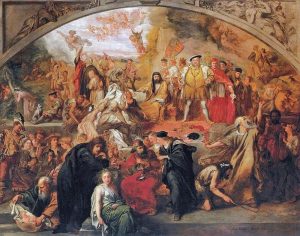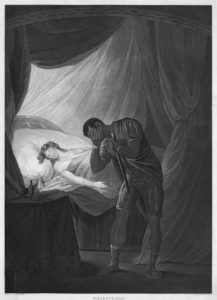Learning to Love Shakespeare

How many characters do you recognize from Sir John Gilbert’s painting, “The Plays of Shakespeare”?
As I mentioned in a post a couple of weeks ago, I have grown to love Shakespeare over the last two decades. Teaching it, reading it, watching it, or even just listening to it, can all make me extremely happy. And as a teacher who started teaching Shakespeare with a very sad amount of prior experience, I have spent much time researching the subject as well. I’ve listened to lectures from the Great Courses on Shakespeare and collected and read a fair amount of books as well.
Shakespeare Experience for Adults
But until last week there was something I had never done connected to Shakespeare – I had never been to any type of teachers’ workshop or other such event with a Shakespeare theme. It’s kind of sad to think that for more than a decade I’ve been attending teachers’ workshops on other topics of interest to me (the U.S. Constitution, Civil Rights, and Economics to name just a few), but had never managed to attend one on Shakespeare.

Okay, so even adults can have fun!
And now that I’ve attended my first, I hope there will be many more to come! My first in-person event wasn’t technically a teachers’ workshop, and didn’t include only teachers – it was a camp for adults – the No Kidding Shakespeare Camp put on by the American Shakespeare Center, to be exact. But much of what we did there will be very useful for those of us who do teach Shakespeare.
Fun with Shakespeare
Earlier in the week I mentioned some of the fun things we did at camp in a post entitled Creativity Comes in Many Forms (on www.CatherineJaime.com). But in that post I didn’t go into most of the actual Shakespeare-related activities we did – several of which I’m hoping to incorporate into this year’s Shakespeare classes. (Yes, I know, I’ve officially retired from homeschooling after 35 years and from running a homeschool center after almost 14 years. But that doesn’t mean I’m quite ready to give up teaching Shakespeare. We’re returning to where we started – classes in my living room.)
Boydell Shakespeare Prints
Our first activity of the week involved pictures – black and white engravings of paintings from different Shakespeare plays. Several years ago I had put together one of my art appreciation books on Shakespeare – and had actually used a few of these prints, but I hadn’t realized how many of them there were in this magnificent collection, painted for the Boydell Shakespare Gallery in the late 18th and early 19th centuries.
Pictures/Scenes from Shakespeare

A Boydell print – do you recognize this play? Answers at the bottom of the post.
It was a fun activity, if a bit overwhelming at first. We had 27 prints on the walls and tables of the room, numbered, 1 -27 (of course). And then we had 27 short passages from different plays printed on several sheets. They were lettered A to Z, plus an AA. We were tasked with identifying which scenes went with which pictures. Extra points if we could identify which plays they were from. Some members of our group even managed Act and Scene numbers – way beyond my Shakespeare knowledge there! But I did go in on the scene sheets and identify almost every play the scenes were from. (I think I was missing 3 names out of the 27.) And I could probably have told you on most of them whether they were from the first half of the play or the second half – but beyond that, not a chance.
My first mistake was not transferring the names of the plays right to our answer sheet. Instead I started trying to identify the pictures, and only wrote the names down as I was putting the letters with the right numbers. Consequently, I only got 32 of the total 54 points possible. (Putting me about 4th in a group of almost 20. Not too shabby for someone with no formal training in the subject.) Had I written in all the play names I knew (and not mixed up As You Like It with All’s Well that Ends Well – something I’m forever doing for some odd reason – though probably not after this!) I would have ended up with more like 40 or more points. Oh well, it was still fun to do.

I think many of my students would recognize the play this picture represents.
Our Variation of the Activity
In fact, the activity was so much fun, I think I’ll start this fall’s Shakespeare classes with a variation of it. I think trying to match scenes, names, and paintings all at the same time would be too much for most of my students, and I find, at least with the students I’ve had in recent years, that they do better with group activities than individual ones.
Identifying Scenes
For my students I plan to divide them into groups (probably of 4 or 5 students in each group, depending on this year’s class size). I will try to make sure my groups contain a mixture of Shakespeare newbies and Shakespeare veterans.
I like to give each group a small white board and a dry erase marker to put their answers on. I’ll have the small scenes typed up and distributed in a package to each group. I’m going to have them take turns reading the scenes aloud. After a scene has been read, they can decide as a group if they know which play it’s from.
After each group has had sufficient time to consider and write their answer down, I’ll have each group read the answers out loud. I’ll keep score of team points on a separate white board. (I’ve used this format often in my classes, and find it works well. We’ve made it into a game of sorts, with just a slight edge of competitiveness. And this way, no one feels singled out if they don’t know many of the answers.) As each scene is identified, the groups will have a place to record the play name, to assist them with the next step.
Identifying Pictures

I considered using this print – most of my students would definitely recognize the thumb biting insult.
After we go through all the scenes I’ll pull out the different paintings/engravings for them to look at. Each picture will match up with a different scene; basically like we did in our activity here in Staunton – the big difference being that the scenes will already have been identified.
I had planned to print copies of each of the pictures, but I’ve been putting them into PowerPoint, and I think it will be easier to just show the slides one at a time from the laptop. So we’ll probably do this like the first portion – with their small white boards for writing answers on.
My class periods are an hour and a half, and I can see this activity and related discussions spreading into most of that first period. But I think it will be a great way to start the semester – reviewing plays that many of them will already be familiar with, and introducing many others.
And if that sounds fun, but too much work to put together, have no fear – I’ve done all the pre-work for you. You can see the set, Shakespeare Activity: Matching Scenes and Pictures, here on CurrClick.
More Activities to Come
I had planned to share about some of the other fun activities that we did last week at camp, but I can see that I will need to spread this over more than one blog post.
Happy learning! And remember, as Hamlet said, “The play’s the thing.”
Cathy
*Prints here are from the Tempest, Othello, and Romeo and Juliet. (Too many characters to identify in the color painting at the top, sorry. )

Leave a Reply